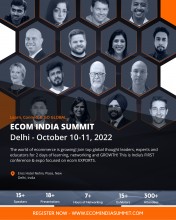- Meghalaya Gears Up for 39th National Games 2027, convenes North Eastern Inter State coordination meeting in Shillong
- Soltrix Technology Solutions, Inc. Recognized by GoodFirms as a Top ServiceNow® Partner
- Baker Law Group Expands Full-Service Criminal Defense to Denver
- DOAGuru Infosystems Delivers Next-Gen Digital Marketing & Software Services to Power Business Growth
- Government of Meghalaya Hosts Summit for Rural Empowerment: Leveraging Pradhan Mantri Janjatiya Vikas Mission
- 4Closure Rescue Launches National Program to Help Homeowners Avoid Foreclosure
- Intel and Times of India Launch 'The Learning Curve' to Bridge Digital Trust Gap in Education
- Personal Online Reputation Management: Why It’s No Longer Optional
- Kronenbourg 1664 Blanc Brings a Taste of French Elegance to Karnataka
- Dr. Sandeep Marwah Honored in Edinburgh, Scotland for Setting Ten World Records in Media and Education
- Galgotias University Celebrates Its Achievement in QS World University Rankings 2026
- SAIMUN 2025 Welcomes 23 Nations and 26 Schools on One Global Platform
- Certified Softwash Solutions Celebrates 7 Years of Exterior Cleaning Excellence in Windsor-Essex
- Tranzlatex Launches as a Global Leader in Translation and Transcription Services
- Solaralm Partners with SolarEdge Solutions to Deliver High-Quality Solar Appointments Across the USA
 Mail to a Friend Mail to a Friend |
|
     |
The Next Idea Restaurant and Food Forecast for 2018
The NextIdea (TNI) anticipates 2018 to be a very exciting year as the ever-changing restaurant and food landscape adjusts itself towards an uncertain yet deeply curious and discerning consumer.
Nelson Mandela once said, ?There is nothing like returning to a place that remains unchanged, to find the ways in which you yourself have altered.? This fundamentally represents the modern consumer?s mindset when it comes to food and eating out. The consumer is a dichotomy between old and new. On one hand, consumers embrace the latest mobile phone and software technology as a need, like drinking water. On the other hand, consumers now aspire to eat the same food as their ancestors!
THE CONSUMER?
Indeed, it is the consumer that will be 2018?s champion for change as, through their combined buying and social media sovereignty, the consumer?s voice will be more powerful than ever.
So, this elusive consumer, what do they actually want? Well, naturally not all consumers are made the same; age, ethnicity, income, and overall demographics all share their role in segmentation. With that said, today?s consumers possess one value that they increasingly collectively care about, and that is their health. While it may seem obvious, consumer health is one of the primary drivers in emerging and materialized food trends, and it is igniting a full array of sub-trends that form 2018?s Food And Restaurant Trend roadmap.
HEALTH LEADS FOOD DECISIONS
Of course, healthy eating is not a new trend, but the velocity at which consumer eating habits have shifted towards healthier eating represents the difference. Both at home and in restaurants, consumer food choice has migrated with a greater emphasis on ?clean? and ?healthy? dishes, and is metamorphosing the eating out landscape at an unprecedented rate.
Historically, ?healthy eating? was limited in options and generally considered a less than favorable culinary experience. However today, consumers have a far more informed opinion when it comes to ?healthy food? options. This is generally due to the swath of cooking channels along with the exponential increase in digital and social media engagement.
Putting this into perspective, Euromonitor pegs the international health food market at a staggering $1 trillion for 2017, with growth in health sectors such as the Asian healthy snack sector forecasted at 14.5% [compound annual growth rate]. Organic food is another example: in the USA, Organic sales totaled around $47 billion in 2016, reflecting new sales of almost $3.7 billion (8%) from the previous year. This compares to relatively nominal growth in more traditional grocery sectors.
In contrast, fast food chains and soda drink brands are witnessing relative decline. For example, Coca-Cola saw a 7% revenue decrease in late 2016 (6th consecutive annual decline). McDonald's is doing well overseas but has not been able to offset declines in U.S. business and has experienced a shrinking number in overall sales.
Combined with intensified interest in global flavors, superfood ingredients, and Instagram-ready dishes, retail food ranges and Restaurant Menus will increase focus on dietary needs and concerns while elevating innovation using foods from the past.
PRIMARY FOOD TREND THEMES
As we head into 2018, there are eight primary themes when establishing future food trends:
Health and Wellness
Food Source
Digital Technology
Honesty
Bold Flavors
Raw Material Technology Reversal
Creative Food Innovation
Sustainability
These themes relate to all future food trends, in some cases at multiple levels, and as such are the foundation to current and future trends.
2018 Trends
1. Faux Meat
Plant-based food is forecasted to be one of the fastest growing trends in 2018. Consumer interest in vegan food has grown significantly over the past 10 years, and we have seen the substantial growth of Vegan chains like Veggie Grill, Amy?s, Native Foods and Southern California-based Plant Power.
The new term ?flexitarian? has been tagged to the ever-growing consumer group who intentionally flexes between eating meat and vegan foods.
Generally, vegan brands are taking traditionally meat-based products, such as burgers and tacos, and converting them into a plant-based alternative, hence the term ?Faux Meat.? This approach appeals to multiple consumer diets, and thus a new market has emerged that is more sustainable and healthier than the US consumers? primarily meat-based diet.
In food retail, plant-based foods sales have risen 8.1% in the last 12 months. And while plant-based products continue to rise in sales, animal product sales are seeing a decline. Dairy alternatives, in particular, have seen a huge amount of growth this year with a 20% increase that amounted to $700 million worth in sales over the past year.
This is in contrast to overall food sales in the US declining by a marginal 0.2% this year. This includes plant-based alternatives to cheese, yogurts, and ice creams, but doesn?t include milk alternatives.
Faux Meat is beginning to take center stage. For example, three San Francisco chefs have put the Impossible Burger, a bleeding veggie burger, on their menus. With the rise of the flexitarians, vegan options of regular food will become available in multiple forms.
The Future...
Vegetable charcuterie will replace salami and beef with smoked carrots, cured beets, mushroom p?t?, beet chorizo, cultured cheese, crabless crab cakes, field roast, and plant-based Cajun shrimp.
The use of algae is expected to expand. Easy to grow and packed with protein, this nutrient rich family of seaweed comes in a range of shapes, tastes, and textures. Algae based products will include toppings, wraps, and supplements. Indeed, the options are virtually unlimited and if farmed correctly, so will be supply!
2. Superfood Powders
Superfood powders have been utilized by various indigenous civilizations for thousands of years. They are extremely dense in antioxidants, anti-carcinogens, vital nutrients, and cell-repairing vitamins & minerals.
A few examples of superfood powder are maca which encourages hormone regulation, moringa with its 13 essential vitamins and minerals, primary amino acids, and antioxidant value, and baobab which contains potassium and vitamin C. However, the superfood powder table is a long list that includes turmeric, pomegranate, cacao, goji berry, maqui, and mushrooms. There are also multiple blends, such as Elixir and Super Elixir, that contain health enhancing attributes.
3. Honesty and Transparency
Consumer demand for honesty traces back to the great recession in 2008/9. The Next Idea reported then that consumer trust in big brands and corporations was at an all-time low. Since then, consumers have upped the tempo, insisting on label transparency, food source information, price integrity, and basic truthfulness from brands.
Armed with the world?s most powerful media weaponry, social media, the consumer calls the shots, and the most sustainable advantage a brand can adopt in today?s market is simple honesty.
Don?t just take our word for it. A 2016 report by Label Insight, a company that collects and analyzes food label data, discovered that 94 percent of consumers would be more loyal to brands that practice transparency, while 56 percent claim that brand transparency would make them "loyal for life." Forbes magazine stated in a 2017 article that ?Authenticity in Marketing Matters Now More Than Ever,? and Fast Company reported in 2014, that the #1 thing customers want from brands is honest communication about their products and services.
Going forward, expect more information on the packaging, more transparent labeling, more info on GMOs, fair trade, ingredients, and traceability.
4. Not Mexican Tacos
The humble taco is trending to become the new sandwich. Consumers are opting to enjoy the taco for more than just Latin and savory dishes. This versatile product is being adopted for multiple food types with the most common being Asian. However, Indian food and Mediterranean options are now being served and marketed.
Tacos are also migrating to different meal parts. Think ice cream and fruit tacos using a sweetened shell. We will also begin to see an evolution of the tortilla where more varieties will be available using heirloom corn and ancient grain flour variations. Tacos will also arrive with different shell types, more lettuce types, and seaweeds. Ethnic breads will play host to what is often referred to as the ?Humble Taco.?
5. Indian Cuisine ? Finally!
Just 10 years ago, Indian restaurants in the United States were few and far between. Of the few Indian food establishments that did exist, even fewer served authentic-contemporary home-style dishes.
However, Indian chefs have recently gained a reputation in the United States, popularizing Indian cuisine by offering Americans a modern taste of India.
Indian food is aromatic, mystical, and flavorful, yet despite many past predictions, it has yet to become mainstream and indeed a food trend. That?s until now, where TNI is predicting a slow but expanding trend in Indian culinary popularity in the US.
Relatively new brands like Indikitch in New York, East Coast-based Choolah, and West Coast-based Dabba, are bringing modern Indian cuisine to the fast-casual market with broad success. Other inspiration is experienced at Tava Kitchen, a chain in the Bay Area that offers Indian-inspired burritos, wraps, bowls, and salads. Biju's Little Curry Shop, a Denver-based brand, offers spicy Southern Indian cuisine. Sweetgreen recently introduced curry cauliflower to the menu. In Los Angeles, The Hungry Trader, a spice route-inspired culinary concept featuring the cuisines of Asia and Arabia, is set to open in February 2018. Its menu includes an Indian street food category, dished up as it was served in olden days.
Indian food is versatile, interesting, and generally very healthy, using high nutrient herbs and vegetables such as turmeric, curry, ginger, and garlic. The modern positioning of this ancient cuisine is expected to grow given the incredible taste and health values combined with its new modern image.
6. Clean Food
Clean Foods are essentially food products that are non-processed or refined, keeping them as their original form, or as close to original as possible.
The concept of clean food is very basic: it evolves around food products coming direct from the source ? Farm to Table, if you like. No additives, pesticides, hormones, or antibiotics.
The concept is actually quite simple. Instead of worrying about meal construction, which means fewer calories, fewer carbs, or more protein, the clean food philosophy is about food's corridor between its derivation and the plate.
This trend possesses complexities as the term ?Clean Food? is vague in nature and interpretation. Most dieticians and nutritionists have distanced themselves from the term since the idiom has been used by various corporations as a marketing buzzword, yet often with some questionability of fact. Notwithstanding, consumers have a general understanding that clean food equals real food, and thus as a philosophy has gained momentum. We are forecasting that this trend will continue.
By way of example, Kroger grocery stores introduced the Simple Truth brand in its stores in 2012. This brand promotes its products as free from 101 artificial ingredients and preservatives, non-GMO, and conforms to their Live Naturally standard. Simple Truth generated $1.7 billion in sales in 2016, and the brand?s sales grew 19 percent in the third quarter of 2017. This is very significant given Kroger, the #1 supermarket chain in the world by revenue, has been reporting marginal same store sales growth since last year.
7. Food is Medicine
Driven by emerging food fortification technologies and discoveries of nutrient benefits, consumers are choosing to make the most of their caloric intake.
Examples of nutritional ?insurance policies? include:
Turmeric: Antioxidant & anti-inflammatory values
Horseradish: Glucosinolate-rich, fights cancer & kills bacteria
Basil: Contains eugenol, keeps intestines safe
Pomegranate: Inhibits cancer growth & deactivates cancer
Ginger: Anti-inflammatory and antioxidant properties
This trend is expected to grow as consumers and doctors understand food intake is part of healing and wellness, thus we expect to see prescriptions of specific diets of foods and recipes that enhance the healing process, enhance immunity, and address specific medical conditions with patients.
New brands like PhoodFarmacy are planned for launch in 2018. PhoodFarmacy will provide specific medical condition-based meal plans while incorporating convenience with tasty meals made from clean ingredients and deep nutritional planning.
8. Sustainable Innovation
Food waste is now a hot topic in the West, mainly a result of consumer concern over the dichotomy of the hungry and wasted food surplus. Further concerns about population expansion and the general wellbeing of the planet places sustainability at the top of the food chain in terms of priorities.
While sustainability is by no means a new trend, sustainable innovation is being adopted at an unprecedented rate. We are seeing companies using food waste as ingredients for consumer products. For example, Pulp Pantry creates granola from leftover juicery pulp, and Regrained makes bars out of spent grain leftover from beer.
In food agriculture, AeroFarms built its ninth farm in 2017. AeroFarms is the world?s largest indoor vertical farm in terms of annual output. They grow high-yielding leafy greens using minimal inputs to provide locally sourced foods while protecting the environment. Their year-round indoor production model uses, on average, 95 percent less water than field farming and yields 390 times higher per square foot annually.
Amazingly, sustainability is still in its infancy. As we move through 2018 we will see water being farmed from air, biodegradable packaging being infused with seeds to generate its own replacement, and greater use of food byproducts that have traditionally been discarded.
9. Alternative Ingredients
There has been an unprecedented innovation in new ingredients fueled principally by consumer desire for sustainability, plant-based product demand, and general innovation. Many food categories are introducing exciting new products with the added advantage of nutrients and sustainability. For instance, in the sugar replacement category, there is now coconut sugar, reduced apple sugar, and brown rice syrup. In the water category, birch water and maple water are available, with pine and even peach tree water predicted to debut.
However, the category that is possibly most interesting, not to mention controversial, is entomophagy: the consumption of insects.
Humans rely on a very narrow range of species to satisfy global food demand. In fact, only 30 species account for 95% of human food consumption.
Insect consumption is very common around the world. In parts of central Africa, for example, around 50% of protein is derived from insects. Thailand?s popular Jing Leed is deep-fried crickets with a soy based dipping sauce. In Mexico, chicatanas, or pan-roasted ants with lime, are popular.
Presently, crickets are the most common insect type being used in the US. For example, brands like Chapul, Flukers, and Chirps, who all specialize in cricket flour and protein products, are experiencing extremely high sales growth.
Other insect types are also expected to become available, including caterpillars, different beetle species, and larvae. Even termites are under experimentation.
Trends in the alternative ingredient market will expand due to consumer curiosity combined with health and sustainability benefits.
10. Virtual Restaurants
Virtual restaurants are to-go or delivery-only food businesses. This segment has grown over 34% since 2013, and is expected to continue to expand in the near future.
This trend is generated by some key technology developments, mainly: 1) Consumer work patterns where today, the desk is the dinner table, home is the office, and the office is the coffee shop, 2) The development of delivery applications where customers can order delivered food with just a few clicks, and 3) development of various easy-to-order third party providers where consumers can choose as follows:
1. Delivery model / online or application ordering (Eg. GrubHub, US)
2. Home cooks connecting to the market (Eg. EatWith, international)
3. Meal kit delivery service (Eg. Green Chef, US)
With rental kitchens becoming more organized and user friendly, start-ups and small businesses can now afford to begin their business in a shared space, thus the supply and demand circle is complete. On the corporate brand level, the response is pro-active: Bloomin Brands (parent company for Outback Steakhouse and Carrabba?s) has opened a new delivery and take-out only concept and Wendy?s has agreed to a 2,500-location rollout with Doordash, one of the larger third party delivery companies.
This trend will grow due to the future ability for companies to pinpoint geo-deliveries, elevated profitability combined with lower operating & capital costs, and developing innovation such as drone and driverless deliveries.
11. Technology & Artificial Intelligence
It is not possible to report on food trends without recognizing the scale of impact that technology has on the food and restaurant industries. Indeed, technology plays an essential part in food trends and consumer behavior
Current food related technologies include online ordering, advance ordering, tablet-based table orders, social media integration, guest-facing technology platforms, and product menu information.
New Technology Concepts anticipated include:
Robotic chef kitchens
Google Eyewear with face recognition software
Apple Pay and other electronic wallets will expand in use
Drone delivery
Driverless delivery vehicles
Enhanced intelligence applications with prediction technology
Voice-controlled virtual assistant
As of now, it is unclear to what extent artificial intelligence will have on the restaurant and food industries. In the short term, not much is expected, however in the longer term, food developed by, made by, packaged by, and delivered by robots is a reality!
12. Current On-Trend Food and Drinks to Watch Out For
1. Jackfruit
2. Unicorn Food
3. Matcha
4. Functional mushrooms
5. Root to stem
6. Sparkling coffees and sparkling sap-based water drinks
7. Poke (watch out for Poke-O in Dallas, TX, opening first half of 2018)
8. Algae
9. Ancient grains
10. Kombucha drinks
About the Author, Robert Ancill
ROBERT ANCILL is the founding partner and owner of The Next Idea Group, an international food and restaurant consulting group based in Los Angeles, CA. He is considered one of the most authoritative voices on restaurant and food trends, and has consulted on launching and positioning many new and existing brands in the USA as well as international emerging and frontier markets.
Contributors
Editor: Thelma Weaver Senior Marketing Consultant, The Next Idea
Graphics: Meriam Hernandez Graphic Designer, The Next Idea
About The Next Idea
The award-winning Next Idea [TNI] is an international restaurant & hospitality concept development and management agency. Based in Los Angeles, TNI works across the world specializing in Concept Creation, development, and management. Everything from research, strategy, brand and product development, franchising through to design, execution, systems and operations, Marketing And Communication.
The TNI team has consulted with some of the world?s most eminent chefs and upscale restaurant groups in addition to working with clients in entertainment, casual dining, fast casual dining, resorts, theme parks, and travel. In each project, TNI has been involved in all areas of the business and has delivered programs and plans that have targeted the elevation of concept positioning, product and menu, operating standards, infrastructure, and overall quality.
For Information contact: info@thenextidea.net / (001) 818 887 7714
Franchise Solutions: www.tnifranchise.net
Consultancy: www.thenextidea.net
Interiors: www.tniinteriors.com
Blog: www.globalrestaurantconsultant.com
Awards
Best End-to-End Hospitality Business Consultancy (Travel Hospitality Awards) 2017
Most Innovative Hospitality Consultancy Group (USA Today Corporate) 2018
City Beat News 5 Star in Customer Service (2013, 2014, 2015, 2016, 2017)
Most Innovative Hospitality Consultancy Group (LUX Hospitality Awards) 2016
Glossary
Sources for this report include:
The Next Idea ground team
The Next Idea marketing department
The Farmacists at PhoodFarmacy
Mintel
Nielson
Euromonitor
Forbes
Label Insight
Fast Company
National Restaurant Association
Company :-The Next Idea
User :- Robert Ancill
Email :-thenextidea@gmail.com
Phone :---
Mobile:- +1-818 887 77
Url :- http://www.thenextidea.net/









